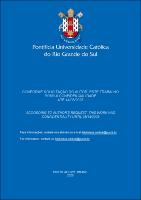| Share record |


|
Please use this identifier to cite or link to this item:
https://tede2.pucrs.br/tede2/handle/tede/9229| Document type: | Dissertação |
| Title: | Distribuição das peritonites por regiões climáticas brasileiras em uma coorte de pacientes em diálise peritoneal |
| Author: | Melere, Camila Borges Mosmann  |
| Advisor: | Figueiredo, Ana Elizabeth Prado Lima |
| First advisor-co: | Poli de Figueiredo, Carlos Eduardo |
| Abstract (native): | A doença renal crônica (DRC) possui elevada prevalência na população mundial. No Brasil aproximadamente 122 mil pacientes realizam tratamento dialítico, entre esses, 7,9% estão em diálise peritoneal (DP). Nessa modalidade terapêutica, peritonite é a principal causa de morbimortalidade e falha do método. Além dos principais fatores de risco: raça negra, diabetes mellitus (DM), idade avançada, obesidade, desnutrição,inflamação crônica, diminuição da função renal residual e peritonite prévia, outros fatores de risco como baixo nível de escolaridade, distância da residência até o centro de diálise e região geográfica também têm sido descritos. A localização geográfica pode determinar diferenças nas características clínicas e nos desfechos de pacientes em diálise, ainda que dentro de um mesmo território, principalmente em um país com grandes variações climáticas como o Brasil. As alterações de temperatura e umidade podem desempenhar um papel no desenvolvimento dessa infecção. Objetivo: Caracterizar a distribuição das peritonites por regiões climáticas brasileiras em uma coorte de pacientes em diálise peritoneal. Método: Estudo de coorte, retrospectivo. Através da utilização do banco de dados de um estudo denominado BRAZPD (Estudo Multicêntrico de Diálise Peritoneal no Brasil), foram analisados 1.631 pacientes incidentes em DP, que apresentaram pelo menos um episódio de peritonite e que permaneceram pelo menos 90 dias nesse método de diálise. As informações relativas à temperatura e umidade relativa do ar foram referentes a média desses valores no mês em que os pacientes desenvolveram peritonite e foram coletadas através do banco de dados do Instituto Nacional de Meteorologia (INMET). Para essa análise, o país foi dividido de acordo com suas regiões climáticas segundo o Instituto Brasileiro de Geografia e Estatística (IBGE). Resultados: Foram incluídos 9.905 pacientes adultos de 122 centros brasileiros, 1631 apresentaram peritonite, total de 2562 episódios de infecção. A média de idade foi de 59,2 ± 16,2 anos e 53,3% (n=870) eram do sexo feminino. Foi detectado aumento do número de casos em janeiro, predomínio de cultura negativa e, entre os episódios com cultura positiva, predominaram gram positivos (GP). A taxa encontrada foi de 0,30 episódio/ano e a comparação das taxas de peritonite demonstrou diferença estatisticamente significativa (p<0.001) entre as regiões. Foi encontrado associação entre umidade e peritonite na região Tropical Brasil Central (r=0,58) e potencial de associação entre o número de infecções e temperatura média nessa região (r=0,47), temperatura máxima na região Equatorial (r=0,44) e potencial de associação negativo entre o número de infecções e umidade na região Equatorial (r=-0,48). Conclusão: Foi possível verificar que a ocorrência de peritonite difere entre as regiões climáticas brasileiras, com predomínio no mês de janeiro. Encontramos associação entre umidade e peritonite na região Tropical Brasil Central. As bactérias gram-positivas causaram a maioria dos episódios e mantiveram distribuição uniforme ao longo dos meses do ano. |
| Abstract (english): | Introduction: the prevalence of chronic kidney disease (CKD) in the world population is high. In Brazil, approximately 122 thousand patients undergo dialysis treatment, of which 7.9% are on peritoneal dialysis (PD). Peritonitis is the main cause of morbimortality and method failure in this therapeutic modality. In addition to the following main risk factors: black race, diabetes mellitus (DM), advanced age, obesity, malnutrition, chronic inflammation, decreased residual renal function, and previous peritonitis; social factors, such as low schooling level, distance from home to dialysis center, and geographic region have also been described. The geographical location may determine differences in the clinical characteristics and outcomes of dialysis patients, although within the same territory, especially in a country with such a climate diversity like Brazil. The changes in temperature and in humidity may play a role in developing this infection. Objective: This study aims to outline the distribution of peritonitis in a cohort of patients on peritoneal dialysis according to the climate regions in Brazil. Method: retrospective multicenter cohort study; data of 1,631 patients who were incident on peritoneal dialysis (PD), presented at least one episode of peritonitis, and had completed at least 90-day therapy were collected from the BRAZPD study (Multicenter Study of Peritoneal Dialysis in Brazil) and analyzed. Information on temperature and humidity were evaluated in each Brazilian region during infection period. Such information referred to the average values in the month which patients developed peritonitis and it was collected from the National Meteorology Institute (INMET) database. The analysis was carried out through the division of the country according to its climate regions, following the Geography and Statistics Brazilian Institute (IBGE) guidelines. Results: a total of 9,905 adult patients from 122 Brazilian centers were included; 2,562 presented episodes of infection. Mean age of 59.2 ± 16,2 yrs. and 53.3% (n=870) of women. It was detected an increase in the number of cases in January, predominance of negative culture and, among episodes with positive culture, gram-positive (GP) predominanted. The present study showed an overall rate of 0.30 episodes per patient/year and peritonitis rate comparison demonstrates a statistically significant difference between regions (p<0.001). Association between humidity and peritonitis in the Central Tropical region (r=0.58) and potential association were found between the number of infections and the average temperature in this region (r=0.47), highest temperature in the Equatorial region (r=0.44), and a potential negative association between the number of infections and humidity in the Equatorial region (r=0.48). Conclusion: it was possible to observe that the occurrence of peritonitis varies among Brazilian climate regions, with a higher occurrence in the month of January. We found an association between humidity and peritonitis in the Central Tropical region and a potential association between the number of infections and the average temperature in this region, highest temperature in the Equatorial region, and a potential negative association between the number of infections and humidity in the Equatorial region. Gram-positive bacteria caused most of the episodes and maintained a consistent distribution throughout the year. |
| Keywords: | Diálise peritoneal Peritonite Clima Umidade e estações do ano Peritoneal dialysis Peritonitis Climate Humidity Seasonality |
| CNPQ Knowledge Areas: | CIENCIAS DA SAUDE::MEDICINA |
| Language: | por |
| Country: | Brasil |
| Publisher: | Pontifícia Universidade Católica do Rio Grande do Sul |
| Institution Acronym: | PUCRS |
| Department: | Escola de Medicina |
| Program: | Programa de Pós-Graduação em Medicina e Ciências da Saúde |
| Access type: | Acesso Aberto |
| Fulltext access restriction: | Trabalho será publicado como artigo ou livro |
| Time to release fulltext: | 60 meses |
| Date to release fulltext: | 14/08/2025 |
| URI: | http://tede2.pucrs.br/tede2/handle/tede/9229 |
| Issue Date: | 8-Aug-2019 |
| Appears in Collections: | Programa de Pós-Graduação em Medicina e Ciências da Saúde |
Files in This Item:
| File | Description | Size | Format | |
|---|---|---|---|---|
| DIS_CAMILA_BORGES_MOSMANN_MELERE_CONFIDENCIAL.pdf | CAMILA_BORGES_MOSMANN_MELERE_DIS | 423.89 kB | Adobe PDF |  Download/Open Preview |
Items in DSpace are protected by copyright, with all rights reserved, unless otherwise indicated.




